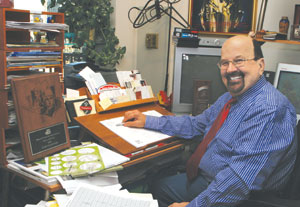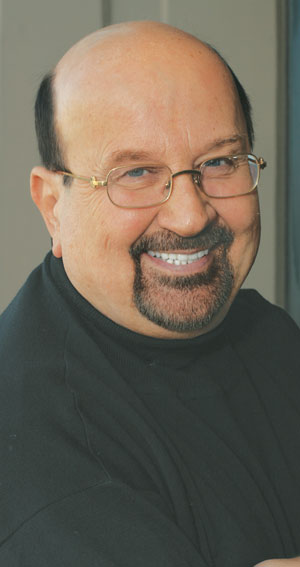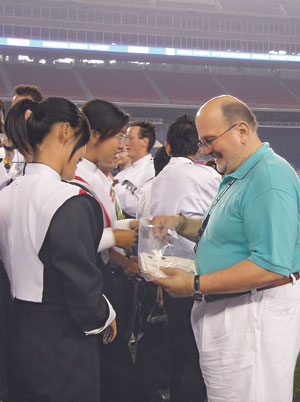DCI Hall of Fame drill designer and judge Gary Czapinski, known as Chops, wrote shows for 25 corps that were DCI finalists in the space of 15 years. His innovations in bringing curvilinear drill to the field with the Santa Clara Vanguard in the 1970s and his effective presentations of characters in costume on the field with the Madison Scouts during the same era led to the creative drill designs and show concepts seen on the field today. Czapinski has nearly 50 years of experience performing and teaching marching bands and drum corps and is still active as a consultant, drill designer, and educator. He is also the president of Visual Musical Designs. Most recently, he presented a clinic on marching band show production at the Midwest Clinic in December of 2009.

What are the principles to consider when producing a show?
You have to tie your whole show concept together. Producing a show means being in control of the show. You should lead your audience from one engaging moment to another, through thoughtful pacing of musical and visual events. Typically, either an audience member or a judge will get an impression from your show (I liked that moment.), analyze that moment (What did I like about it?), and then evaluate or compare it (This band is better than the last band.). The goal is to have a show that is so interesting and well produced that both the audience and the judges are led from one great impression to the next without time to analyze or evaluate, just being entertained. This does not mean louder, faster music or faster, more athletic drill. In fact, some of the best moments in any type of artistic performance are the most delicate ones.
I believe it is possible to win a lot of championships with 40 pages of drill and a good story line. Engaging the audience in a meaningful way is always going to have more audience appeal and more competitive success than just putting a bunch of stuff on the field. It is important to choose a show that the audience can relate to. You don’t want them asking a lot of questions about it. That might be stimulating, but if they are wondering what the show is about they’re not necessarily engaged or intrigued by what they’re watching. They are not analyzing what they see. If the acts in the show are believeable and the pacing is good, then you have captured the audience, and they are yours.
You want to choose a show that is appealing, avoiding ideas like ants in the 1800s and their plight of going over a river. I’ve seen shows sometimes reach that level of strangeness. The point is to make a show about something the audience can relate to. Then the crowd is engaged and intrigued by what they see without analyzing it. If people come to a show to have a good time and be entertained, they really don’t want to know why the girl on the field is being chased around by people in masks. If the story isn’t good, people spend their time trying to figure out what the show is about.
One of my heroes is world-renown Broadway director Harold Prince, who said, “Don’t let the notes get in the way of emotion.” I think that for many band directors, that is often the case. They are so busy doing the math, that is, analyzing the rhythmic figures or sharps and flats, that they forget to think about music in terms of the rise and fall of the phrase. Band directors miss out on the big picture by obsessing over the individual notes that should work together to create the big picture. Great stage directors work from this principle all the time. They routinely shorten the dialogue or alter the scenes in a play to advance the plot. Great movies do this as well. Don’t get lost in the process of getting to the product.
One of my mentors was Donald Angelica. He marched in drum corps with the Holy Name Cadets (the precursor to the modern Cadets Drum and Bugle Corps) but also had a graduate conducting degree from the Eastman School of Music. He worked as a music supervisor in New Jersey for many years. He also developed the judging system still in use by drum corps. Angelica took a number of young DCI instructors under his wing, including George Hopkins of the Cadets and Wayne Downey of the Blue Devils. He took us to Broadway musicals, stage plays, the ballet, the opera, and to orchestral concerts, and helped us to identify the common threads between all these disciplines. At dinner after these events, we would have to tell Angelica what we liked, what our favorite parts of the performance were, and why. He was the one that got us all to start thinking in terms of production, the idea that the flow and pacing of the events in the performance should be carefully planned out in terms of time in minutes and seconds.
What are the most important elements of designing a show?
 Before I create a single page of drill, I start by listening carefully to the music without a score, focusing strictly on the ebb and flow of the sound. Then, I graph the action on paper using lines and squiggles to identify the peaks and valleys of a piece of music. I call this graph a sound poem, and it literally represents the direction of a piece of music, from moments of high energy and volume to moments of rest and quiet. I will then create a story board or a segment sheet that describes in words the musical events that take place and their duration as well as their possible implications for visual performance and design. At this point, I may throw out the tune for use in the show, because it may not have enough contrast. Some very fine music can actually be monochromatic; while it may be good music, it is a poor choice for the field.
Before I create a single page of drill, I start by listening carefully to the music without a score, focusing strictly on the ebb and flow of the sound. Then, I graph the action on paper using lines and squiggles to identify the peaks and valleys of a piece of music. I call this graph a sound poem, and it literally represents the direction of a piece of music, from moments of high energy and volume to moments of rest and quiet. I will then create a story board or a segment sheet that describes in words the musical events that take place and their duration as well as their possible implications for visual performance and design. At this point, I may throw out the tune for use in the show, because it may not have enough contrast. Some very fine music can actually be monochromatic; while it may be good music, it is a poor choice for the field.
I do not begin writing the drill until I find a piece of music that has sufficient contrast. My goal is to make the music visual and bring it to life. Creating drill is a lot like architecture, in that forms flow from strong to weak. Your starting point for a visual idea determines the number of possible transitions out of that idea, so a good beginning is ex-tremely important. Vis-ually strong or complete forms suggest opportunities for the drill to flow out of these forms. Forms can be changed or evolved through manipulation and a sense of linear development. Incomplete forms create opportunities to resolve into strong forms, which should always coincide with points of musical resolution. Writing drill is like shooting pool. It is just as important to set up the next shot as to sink the current shot. Doing so requires a great deal of planning.
What are some of the common mistakes you see in the design of high school marching band shows?
Lack of a focal point and poor transitions are the most common mistakes I see in shows of all kinds. A show designer should know where the focal point is at any given moment, and that focal point should shift around, both through staging on the field and through the music. These things do not happen by accident. They are always the result of careful planning.
Many times band directors cannot identify the focal points of their own show. If they do not know what part of the show they would like me to focus on, how am I supposed to know what to reward? As a judge, I want to reward achievement. If I can’t tell what to watch due to competing visual priorities, then it is hard to give a reward. Many times, bands will upstage themselves. For example, a soloist may be performing quietly at the front of the field, and he should probably be the focal point. However, in back of the field the color guard is running to pick up new flags. Because of their velocity, the eyes of the audience and the judge are drawn to the guard, instead of to the soloist, which blurs the focal point.
When you talk about focus you have to start talking about the principles of design, which are the guidelines for everything in art: line form, balance, dimension, space, color, texture, mass, dynamics and movement, development and direction. You are the center of attention if you move faster than everyone, have more color than everyone else, move in the opposite direction from everyone else, or have more mass and density. These things make you more visually interesting. An example would be a symmetrical form with a tuba player who is lost and moving at a 45-degree angle trying to find his spot. Everyone is watching the tuba player.
When writing drill, I use what I call the 1-2-3 Principle. Basically, this refers to creating three layers of visual interest on the field. Watch any ballet or dance production, and you will quickly see that the dancers in the front, the prima ballerinas, are performing the most demanding choreography. Those in the middle of the stage are performing work that is less difficult but still complements the dancers in the front. Dancers in the back are performing even simpler work.
One type of action that might work on the field is to have the performers in the front third of the field do something on every count. Performers in the middle of the field might move on every other count, while performers in the back of the field might move every fourth count. This creates three layers of visual interest, which creates a depth of design that is extremely appealing.
Another way to use this idea is with spacing. The marchers in front, instead of being four steps apart, are five steps apart. The next group is seven steps apart, and the back group is nine steps apart. When you look at it from the stands, it all appears to be equidistant. If you’re in the first position, you can make small movements, but the farther back you go, the more those movements have to be defined, to the point that movements in the back have to be somewhat exaggerated, because what you’re trying to do is give definition to the form. This is similar to what everybody learns about circles in college. A circle is a circle in the first quadrant, it becomes a little bit oval in the second, and it’s quite oval in the back.
What is the most overlooked aspect of drill design?
Both designers and performers seem to forget that the transitions between drill sets are the most critical part. Getting into and out of your drill sets is the art form; the integrity of the form only makes up 20% of a show, leaving 80% for how you get there. Drill design is all about transitions, not the points of resolution when the form finally stops.
When people are in a formation it’s good that they hit it, but how did they engage us getting there or surprise us or entertain us during a transitory part of the music? How did we control the focus or intrigue or entertain people while we were doing it? That’s why I say transitions are more important. A moment of musical and visual arrival can be destroyed by poor transitions.
What are the most important things to cover in a visual basics program?
Teaching visual basics takes three phases. Phase one: People first need to know how to hold themselves and move their bodies as individuals. Phase two is moving to a block band, teaching lines, intervals, and distances – the things we still have left from military block bands. The final aspect of visual basics is the most important: spatial awareness drill by location and speed – taking the actual forms and using these as a syllabus for rehearsal.
It is easy to become lazy and use the path of least resistance in certain areas. At band camp, drill is taught dot-to-dot, which was invented in drum corps and is based on being able to teach a certain step size for every demand in the show for every person. Most people did not figure out that doing this would take hours of training to develop individual judgment. Consequently, teaching a 32-count transition in band camp may have been a breeze, but cleaning it will be a disaster. If during counts 16-18 the form and integrity of a formation is a disaster, this is a bad transition.
The integrity of the form between resolution points is important, but people don’t realize how much it matters when they are conditioned to go dot-to-dot and simply think about the beginning and the end. Students need to be trained in what size of step it takes to make this work compared to the person next to them.
What is the most difficult part of judging?
Judging takes both flexibility and consistency. You have to be able to put aside the night before, the day’s events, not getting any food, getting lost on the way there, your plane getting canceled when you walk into the stands. Then you have to be fair and accurate, focusing only on what you’re evaluating without letting your mind get cluttered with everything that happened before I got there or the previous group’s performance.
What advice would you offer to inexperienced marching band directors?
What I learned the hard way was how to manage my time in rehearsal. When I was a young instructor and designer, my mentor, Rick Maass, proved to me that I was spending 80% of my time on the first production of the show.
This was because I saw errors and let them control me; I had to fix everything I found. I would have students keep going back to the starting formation and repeating it. Because of this, the back half of the show was a disaster. It was eye-opening to realize that even though the sets in the back half of the show were horrible, I never got to them. I eventually learned to pace a rehearsal for the good of the whole show rather than nitpick from the beginning.
It is ideal to get into the habit of teaching and cleaning in two- or three-step progressions rather than doing one move at a time. Most of the time you can draw a line every three segments, such as a 32-, a 16-, and a 32-count move. Think of those three as one act, design them that way, teach them that way, produce them that way, and clean them that way. This helps string the show together in students’ minds.
When designing drill, there is always room for a company front. When you’re producing, a company front could be 100 red flags or things that are proven to work. Young designers sometimes want to avoid those things because they want to be original, but the creativity of what you can do on a basic football field is somewhat limited by the stage and what the elements are.
Show designers should use both forms and shapes. A form looks soft like a pillow, whereas a shape has power points around it, like if someone stuck a stick into the pillow and there is now a point. Power points are definition and provide clarity of shape. A lot of times when I go in to clean up a group, all I do is make the shapes more defined, and they look cleaner.
Finally, giving students as much detail about production as possible helps them evaluate themselves and each other. If a student is playing too loud, another member of the section can remind that student that this section was supposed to be soft. If students know what they are supposed to do, they will usually do it.
.jpg) Gary’s wife, Marie, is a co-founder of Winter Guard International and a member of the Bands of America Hall of Fame. Gary says, “Marie is an integral part of my company and my life. Every night we talk for several hours about our various creative projects, judging situations we have encountered, or what our friends and former students are doing. We wait to eat dinner until we have caught up on our personal and professional lives in this way. I respect her, and she respects me. It makes for a good marriage.”
Gary’s wife, Marie, is a co-founder of Winter Guard International and a member of the Bands of America Hall of Fame. Gary says, “Marie is an integral part of my company and my life. Every night we talk for several hours about our various creative projects, judging situations we have encountered, or what our friends and former students are doing. We wait to eat dinner until we have caught up on our personal and professional lives in this way. I respect her, and she respects me. It makes for a good marriage.”





